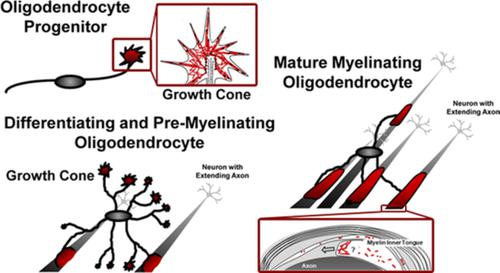Our official English website, www.x-mol.net, welcomes your feedback! (Note: you will need to create a separate account there.)
The oligodendrocyte growth cone and its actin cytoskeleton: A fundamental element for progenitor cell migration and CNS myelination.
Glia ( IF 6.2 ) Pub Date : 2019-11-07 , DOI: 10.1002/glia.23735 Elizabeth J Thomason 1 , Miguel Escalante 1, 2 , Donna J Osterhout 3 , Babette Fuss 1
Glia ( IF 6.2 ) Pub Date : 2019-11-07 , DOI: 10.1002/glia.23735 Elizabeth J Thomason 1 , Miguel Escalante 1, 2 , Donna J Osterhout 3 , Babette Fuss 1
Affiliation

|
Cells of the oligodendrocyte (OLG) lineage engage in highly motile behaviors that are crucial for effective central nervous system (CNS) myelination. These behaviors include the guided migration of OLG progenitor cells (OPCs), the surveying of local environments by cellular processes extending from differentiating and pre-myelinating OLGs, and during the process of active myelin wrapping, the forward movement of the leading edge of the myelin sheath's inner tongue along the axon. Almost all of these motile behaviors are driven by actin cytoskeletal dynamics initiated within a lamellipodial structure that is located at the tip of cellular OLG/OPC processes and is structurally as well as functionally similar to the neuronal growth cone. Accordingly, coordinated stoichiometries of actin filament (F-actin) assembly and disassembly at these OLG/OPC growth cones have been implicated in directing process outgrowth and guidance, and the initiation of myelination. Nonetheless, the functional importance of the OLG/OPC growth cone still remains to be fully understood, and, as a unique aspect of actin cytoskeletal dynamics, F-actin depolymerization and disassembly start to predominate at the transition from myelination initiation to myelin wrapping. This review provides an overview of the current knowledge about OLG/OPC growth cones, and it proposes a model in which actin cytoskeletal dynamics in OLG/OPC growth cones are a main driver for morphological transformations and motile behaviors. Remarkably, these activities, at least at the later stages of OLG maturation, may be regulated independently from the transcriptional gene expression changes typically associated with CNS myelination.
中文翻译:

少突胶质细胞生长锥及其肌动蛋白细胞骨架:祖细胞迁移和中枢神经系统髓鞘形成的基本要素。
少突胶质细胞 (OLG) 谱系的细胞参与对有效中枢神经系统 (CNS) 髓鞘形成至关重要的高度运动行为。这些行为包括 OLG 祖细胞 (OPCs) 的引导迁移,通过从分化和预髓鞘化 OLGs 延伸的细胞过程对局部环境的调查,以及在活动髓鞘包裹的过程中,髓鞘前缘的向前移动沿轴突的鞘内舌。几乎所有这些运动行为都是由肌动蛋白细胞骨架动力学驱动的,该动力学在位于细胞 OLG/OPC 过程尖端的 lamellipodial 结构内启动,并且在结构和功能上类似于神经元生长锥。因此,在这些 OLG/OPC 生长锥上,肌动蛋白丝 (F-肌动蛋白) 组装和分解的协调化学计量与指导过程的生长和引导以及髓鞘形成的启动有关。尽管如此,OLG/OPC 生长锥的功能重要性仍有待充分理解,并且作为肌动蛋白细胞骨架动力学的一个独特方面,F-肌动蛋白解聚和分解在从髓鞘形成开始到髓鞘包裹的过渡开始占主导地位。本综述概述了有关 OLG/OPC 生长锥的当前知识,并提出了一个模型,其中 OLG/OPC 生长锥中的肌动蛋白细胞骨架动力学是形态转换和运动行为的主要驱动力。值得注意的是,这些活动,至少在 OLG 成熟的后期阶段,
更新日期:2019-11-07
中文翻译:

少突胶质细胞生长锥及其肌动蛋白细胞骨架:祖细胞迁移和中枢神经系统髓鞘形成的基本要素。
少突胶质细胞 (OLG) 谱系的细胞参与对有效中枢神经系统 (CNS) 髓鞘形成至关重要的高度运动行为。这些行为包括 OLG 祖细胞 (OPCs) 的引导迁移,通过从分化和预髓鞘化 OLGs 延伸的细胞过程对局部环境的调查,以及在活动髓鞘包裹的过程中,髓鞘前缘的向前移动沿轴突的鞘内舌。几乎所有这些运动行为都是由肌动蛋白细胞骨架动力学驱动的,该动力学在位于细胞 OLG/OPC 过程尖端的 lamellipodial 结构内启动,并且在结构和功能上类似于神经元生长锥。因此,在这些 OLG/OPC 生长锥上,肌动蛋白丝 (F-肌动蛋白) 组装和分解的协调化学计量与指导过程的生长和引导以及髓鞘形成的启动有关。尽管如此,OLG/OPC 生长锥的功能重要性仍有待充分理解,并且作为肌动蛋白细胞骨架动力学的一个独特方面,F-肌动蛋白解聚和分解在从髓鞘形成开始到髓鞘包裹的过渡开始占主导地位。本综述概述了有关 OLG/OPC 生长锥的当前知识,并提出了一个模型,其中 OLG/OPC 生长锥中的肌动蛋白细胞骨架动力学是形态转换和运动行为的主要驱动力。值得注意的是,这些活动,至少在 OLG 成熟的后期阶段,



























 京公网安备 11010802027423号
京公网安备 11010802027423号